EBOOK
How to Win in Global E‑Commerce
Published: Aug 9, 2017
What you’ll get from this guide
International trade was once solely the playground of multinational behemoths – but now the internet has levelled the playing field and given even small and medium-sized enterprises the opportunity to scale internationally through global e-commerce.
And yet, opportunity isn’t enough. Growing your brand overseas is more complicated than simply creating a foreign language website and waiting for new markets to come knocking.
From the duties and tax of the region you’re expanding into, to the logistical challenges of delivering halfway around the world and localizing your message to resonate with your target market – expanding into new territories is never an easy task.
This guide is here to help – we’ll outline the key considerations and potential hurdles you need to consider when devising your international e-commerce strategy, so you can boldly venture into new markets successfully.
Don’t forget your passport…
Why is global e-commerce important?
Put simply, international e-commerce is important because the predicted growth is astronomical.
Within four years, the number of international internet users is predicted to increase by 1 billion people, bringing user totals to around 52% of the entire population.
Other more optimistic predictions believe that by 2020 there’ll actually be over 7 billion internet users.
Whatever the end result, the general consensus is the same. In the very near future, the internet population will be drastically larger than it is today, creating a far larger global e-commerce market.
The interesting element is where many of these new users are based. Much of the advice regarding e-commerce growth is focused on the developed nations of the world such as Europe and the Americas. However, internet penetration within these regions is relatively saturated, leaving little room for growth.
Turn your attention instead to Africa, the Middle East and China and you’ll find rapidly increasing use of the internet thanks to the proliferation of more affordable mobile devices.
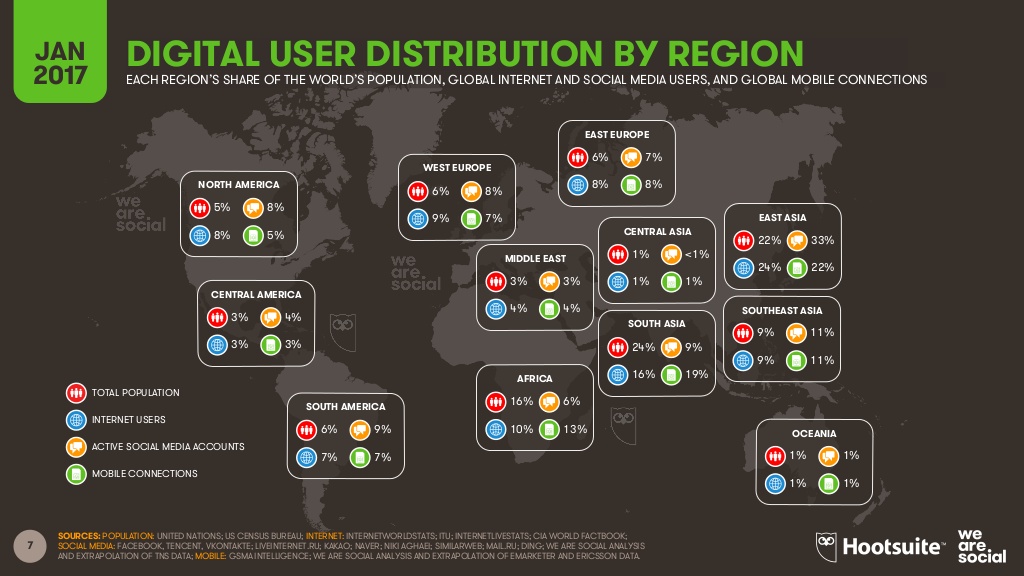
What makes this growth even more interesting for e-commerce brands are the regions’ growing middle classes:
- Africa middle class – today 350 million, predicted to grow to 1.1 billion by 2060 (source)
- China middle class – today 225 million, predicted to become 275 million by 2020 (source)
- Mid East middle class – today 195 million, predicted to grow to 228 million by 2020 (source)
The middle class across the globe is set for a growth explosion, and with it, the amount of disposable income that’s spent on products and services. This growth is set to make international e-commerce the new norm for online brands.
Forrester predicts cross-border e-commerce will make up 20% of all e-commerce transactions by 2022 and top sales of $627 billion. However, this isn’t to say that a slow build to 2022 is the best plan of attack for your brand: cross-border e-commerce is already a huge opportunity for brands looking to grow their customer base.
Few brands seem to realize this, but China has already surpassed the combined total of the US and UK markets with $750 billion spent online in 2016. Africa and the Middle East are also on the rise, clearing 45 billion in 2016 and predicted to exceed 51 billion by the end of 2017:
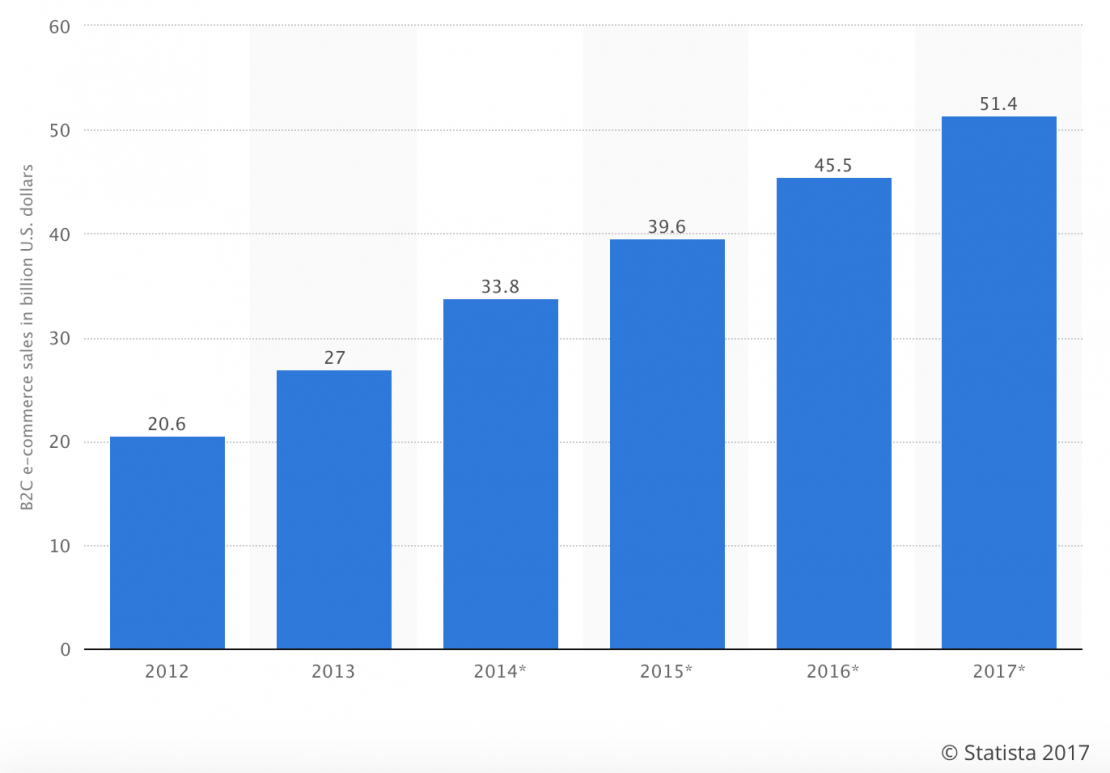
Brands looking to expand their e-commerce operations over the next five to ten years would do well to turn their gaze to international e-commerce today. The bigger lead you have over the competition, the better your chances of long-term gains.
Whilst you could experiment with marketplaces such as Amazon, Rakuten, and other international markets, it’s not always an advisable long-term strategy.
For starters, you’ll lower your profit from every sale by having to also pay the marketplace you’re using. You’re also subject to their rules and regulations, and, according to various user reports, too many returns or complaints could result in penalties and lower sales.
These networks also aren’t truly worldwide. China in particular doesn’t use Amazon and instead relies on several e-commerce networks including Taobao, Alibaba, and JD.
Whether looking to spread into more accessible markets like mainland Europe or those with more rules like China, you should be planning on a long-term strategy to set up your own store.
In this guide we’re going to run through some of the challenges you need to consider to start implementing your own e-commerce strategy for any region of the globe.
Business regulations and compliance
The way governments treat national and international businesses is often very different. As an international brand, you’ll have more hoops to jump through than your domestic competition.
If your business is located within the EU and looking to expand into other EU nations, you shouldn’t face too many difficulties. European regulators are focused on implementing the Digital Single Market, ensuring all EU residents have access to digital goods across all EU member states.
However, China in particular makes the process more complicated. In January 2017 China’s President implemented the Open Door Policy welcoming foreign trade.
While it seems like a positive progression, there are many questions surrounding the announcement as many foreign firms feel they’re less welcome to operate within China’s borders than in the past. This kind of government interference can prove a huge problem for brands looking to expand into the world’s largest e-commerce market.
This is especially true if the Chinese government introduces requirements similar to those in place for spending money overseas. At the time of writing, the government requires all Chinese banks to report any overseas withdrawals over $147. They also have to report any overseas cash transactions exceeding 50,000 yuan ($7,201).
These sort of limitations on spending with foreign businesses could dissuade people from purchasing, and need to be taken into account when considering whether to expand into the potentially lucrative Chinese market.
The way you incorporate your business can also have implications for your freedom and ongoing operation. Whatever country you’re looking to expand into, be sure to implement a full cost-benefit assessment to understand whether you’d be better off working as a foreign company, or whether you should incorporate a new arm of the business in your target country.
Data collection and storage
Data forms the backbone of every successful marketing strategy.
AdWords, user journey mapping, CRO efforts, and UX design are optimized based on user interaction data. Smart e-commerce brands also collect contact information for follow-up promos and email campaigns. The collection and storage of user data is key to continued growth.
But you have to be cautious about how you collect and store that data – and that’s never more important than when you’re setting up shop for international e-commerce.
Just having a secure network isn’t enough to keep even the most data protection agencies happy. Various countries have very specific rules about sharing consumer data across international borders.
Agreements like the safe harbour agreement mean that it isn’t always possible to set up a satellite store in a foreign country, yet collect and analyse data in another.
Some countries apply stringent checks to ensure that the information of their citizens is not leaving the country’s borders. You’ll have to check whether you’re permitted to collect data in one location before analysing it in another.
The easiest way around this is to utilize local servers within the country you’re targeting. However, this would also require you to have a team within that location. Consider what works best for your business.
Logistics
Delivery and returns issues can be a real headache at the best of times. Add a huge distance, multiple haulage providers, and the potential language barrier and it’s only matter of time before things get complicated.
The majority of e-commerce brands place price as the primary consideration when choosing delivery methods. Not unreasonable considering the delivery of a product from local warehouse to foreign destination could use 3-4 different providers.
However, the real focus should be on speed and reliability.
Getting from A to B quickly is your first priority. In local e-commerce, one key factor contributing to cart abandonment is delivery time. This isn’t going to be an issue exclusive to your home market’s customers – all consumers want their purchase as soon as possible.
The reliability of your haulage provider should also be prioritized. As the number of people turning to e-commerce increases, so too do the number of returns. 30% of online retailers list returns as a key negative effect on their profit margins. If your delivery provider causes damage to your products during transit, the likelihood of returns is going to be far higher.
There are two potential solutions to minimize delivery-related risks.
The first is to hire experienced international delivery experts like DHL. You’ll still have to navigate the issue of long delivery times, but with their experience the chances of returns through damage will be minimal.
You can also sweeten the deal and negate the long delivery times with relevant incentives like Harrys of London, who offered free shipping to all international clients to facilitate sales. It’s a risky tactic when you consider the high number of returns. However, Harrys mitigated the damage by ensuring free delivery came with a spend threshold. Users would have to hit a certain cart value before free shipping was available, effectively raising the overall average order value.
The second solution is to purchase local storage. This will reduce both delivery times and the delivery cost from the international warehouse to destination, but it’s not without its own hurdles.
You’ll have to pay for shipping to the warehouse, but you’ll also have to pay the warehouse for ongoing storage and maintenance fees, all of which can add up.
However, the biggest issue with delivering overseas is the red tape.
Often, storing large quantities of product within a country means you will have to pass more stringent customs and import checks. China in particular has some very strict rules. First, everything has to be certified by the Chinese government. This certification is an expensive step and can be very time-consuming.
On top of this, every country has certain products that require extra checks or are outright banned.
For example, China requires extra checks and fumigation for any wood products, including those that are delivered on wooden pallets. South Africa prevents any shipping of any kind of fur products.
You need to complete a full cost analysis of both procedures based on predicted sales to see if it is worth you shipping by the order, or in bulk to a local warehouse.
Payment
Payment solutions for western e-commerce markets are relatively easy. Integrating with Paypal, Stripe, and accepting Visa will handle the majority of payments.
However, different countries and regions have vastly different payment methods.
You can try and offer international bank transfers, but beware – this can scare customers off while accruing a king’s ransom in processing fees.
The best thing to do is: your homework. You have to know the preferred payment solution in the country you’re expanding into, and you have to understand how that payment can be brought out of the country.
Let’s first look at the major payment solutions across various key regions.
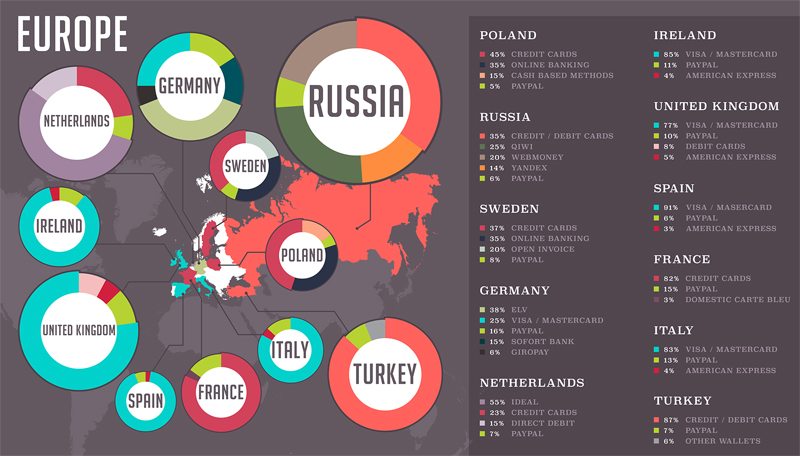
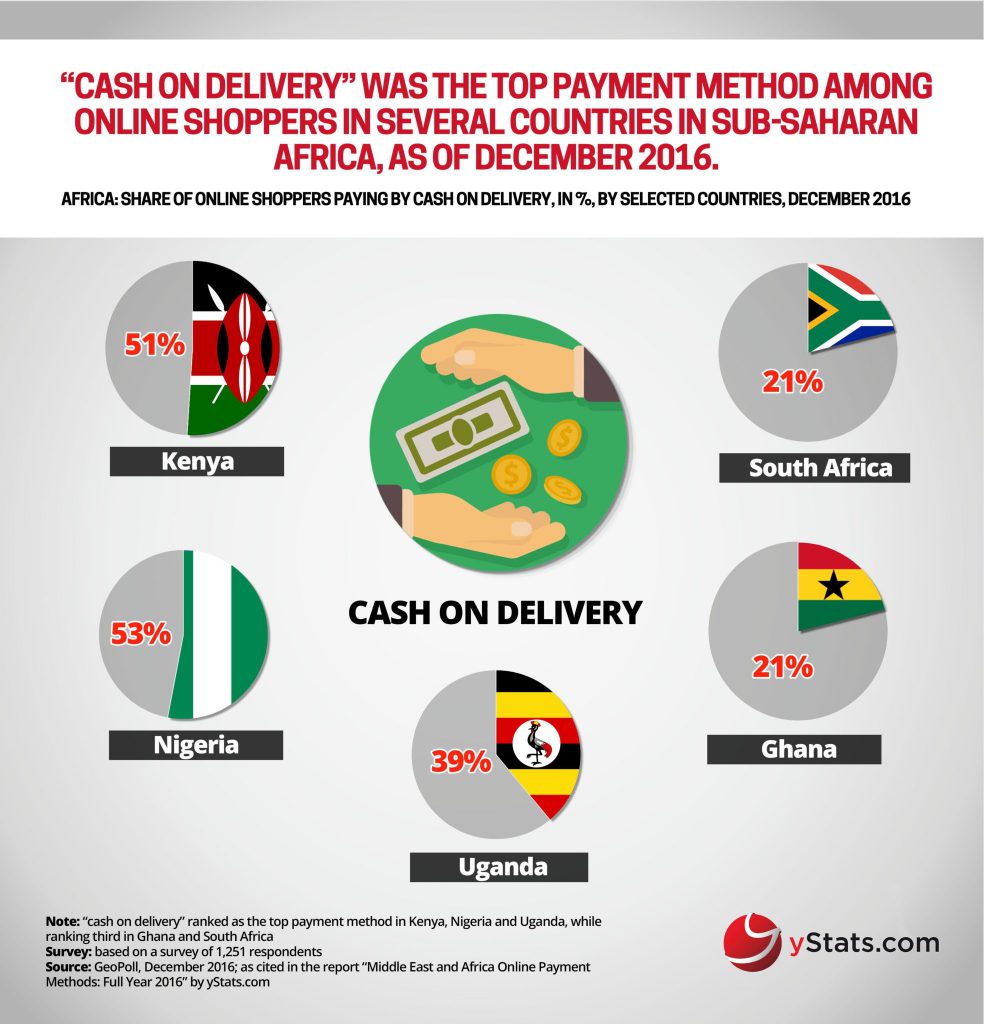
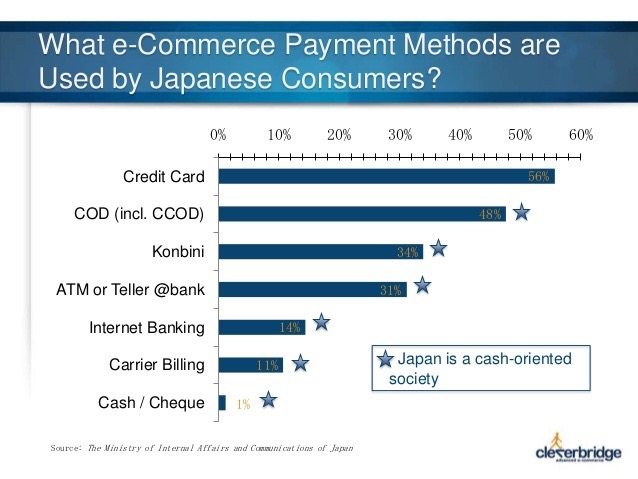
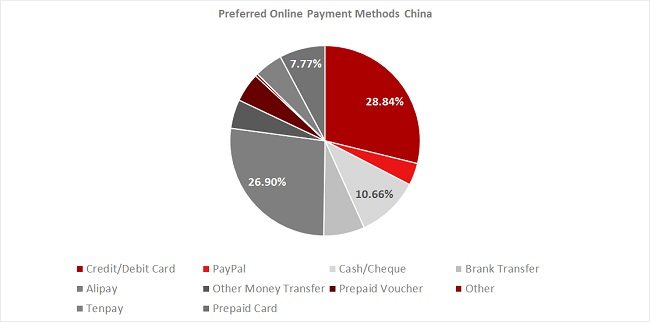
The other issue with global e-commerce payments is the ever-present risk of fraud. Unfortunately, the current verification services implemented by many credit and debit card providers simply won’t work when servicing an international consumer base.
There are some services exploring more secure methods of personal identification that should help reduce the number of fraudulent payments. Pipl offers such a service and they cross-reference a number of metrics not currently used by card companies including address, name, email, and phone number.
In the meantime, it’s down to you to see what works for your target market by researching what other providers are using and finding the most customer-friendly and secure solution.
Localization
Communication is a key component of any marketing endeavour. The right message delivered at the right time and in just the right way can turn a passing glance into an interested prospect.
But finding the right message is something of a minefield. Even professional copywriters, whose sole job is to find the right words to sell products, have managed to sink international campaigns and brands through poorly-written copy.
When selling across borders, the potential for unwittingly offending is an ever-present risk. Even when working in the same language, regional slang can scupper even well-targeted campaigns.
Here’s an example. Both the US and UK speak English (though some in each country would likely beg to differ). However, certain regional terms are likely to feel clunky, odd, or even confusing to those across the pond. This ad for the Rasa City Car shows a term that simply doesn’t translate:

The word boot is only used for a shoe in the US. Some people may understand it means ‘trunk’, but others might find it confusing. It’s a tame example, but there’s the potential to cause offence with a poorly localized campaign.
Go beyond translating your USPs, key product features, and marketing collateral into the local language. Look at how regional slang terms and associations can impact your message.
Localization goes beyond messaging. To ensure a good market fit, you’re going to have to analyse every element of your campaign including:
Demographic differences
In the west, the average online shopper is ~40 years old. In China, the average shopper is 10 years younger.
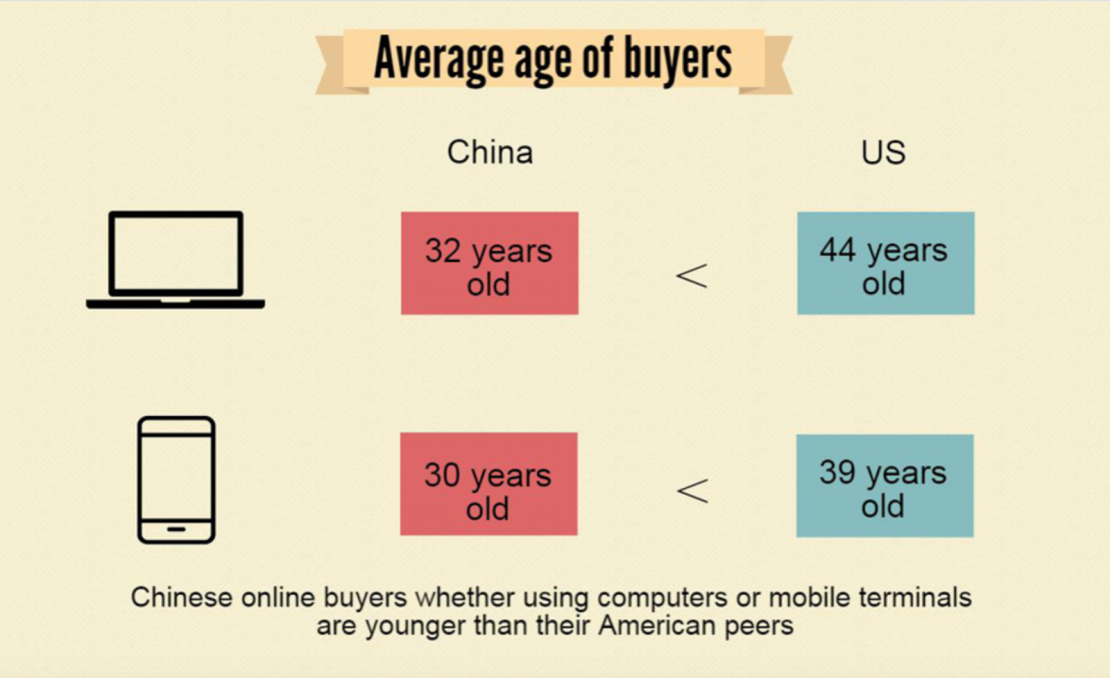
Product images
If you’re using models to demo products, you’ll want to ensure that these reflect your target audience in different markets as Huawei has demonstrated below.


Understand local shopping habits
In developed e-commerce markets, mobile is becoming popular. However, the majority of sales are still completed on desktop. But in developing markets like China and Africa, e-commerce growth is due to the proliferation of mobile devices, so you should be optimizing for those channels first.
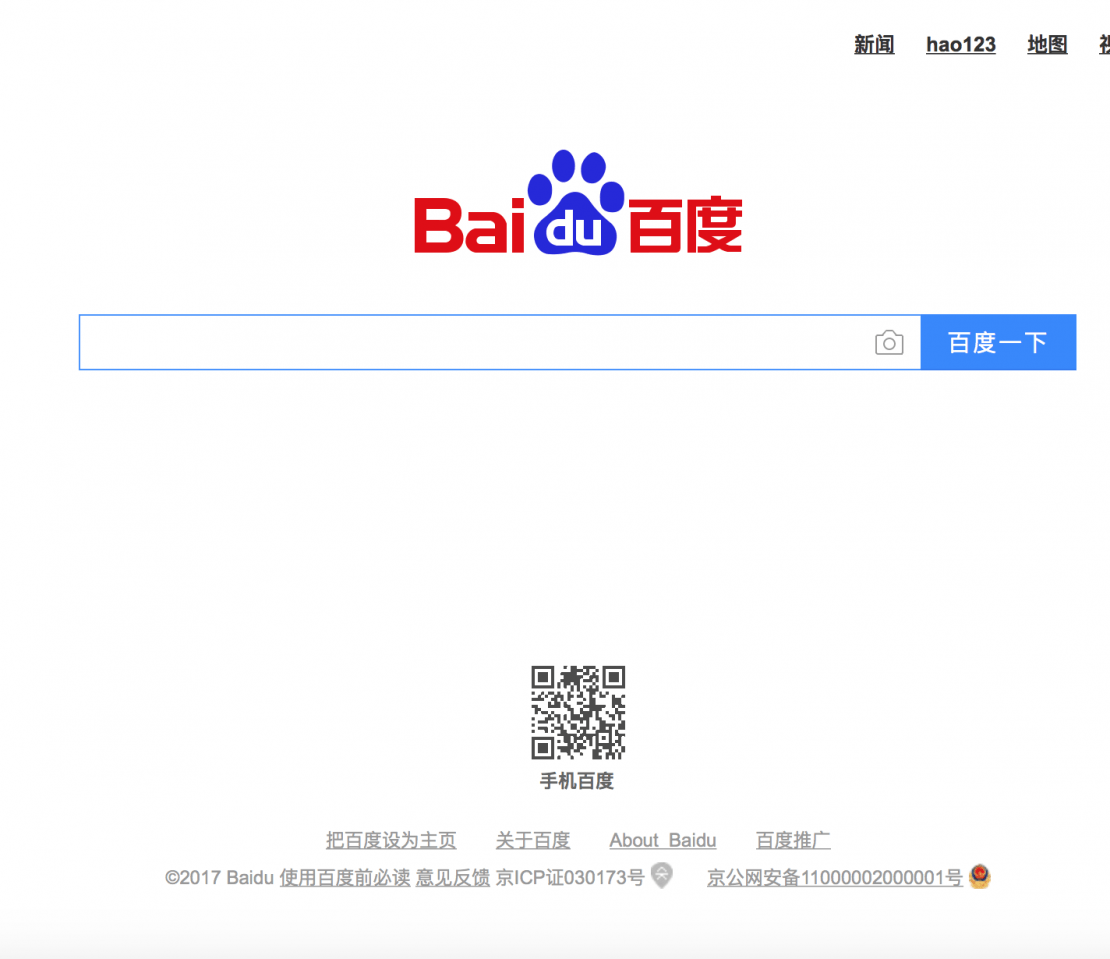
When selling to international markets, you can adapt much of your existing marketing collateral and strategy. However, the adaptation needs to consider the local market and ensure that the messages, images, and method fits with existing user habits.
You need to appear like a local brand, not a foreign company trying to exploit a foreign market.
International Digital Marketing
Having a great product and setting up a local store is not – on its own – a recipe for success.
You still need to properly market your brand and, just like in the markets you’re accustomed to, SEO and PPC are the key methods to increase traffic and reach.
Generally speaking, Google holds the monopoly here. For nearly every region in the world, Google will serve as the most logical starting point for both your SEO and PPC strategy.
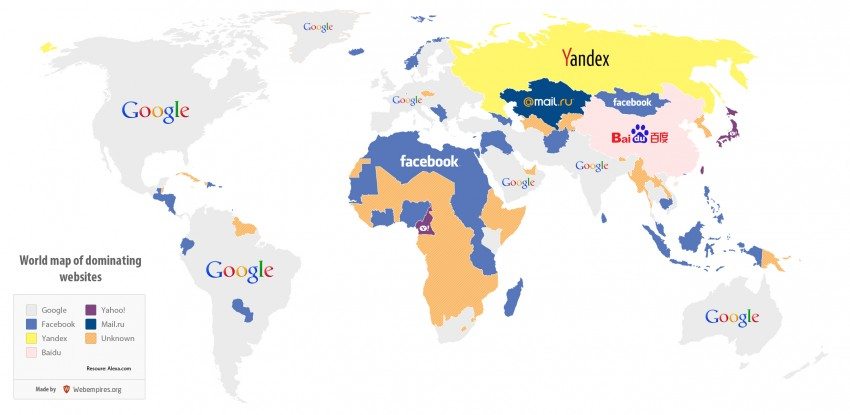
Bringing up the second position is Facebook as the largest international social media network.
Once you have your strategy sorted for these two, you can start expanding to include engines like Bing or more relevant local engines.
However, China once again throws a spanner in the works. In China, Google has an estimated reach of around 2 million, which is next to nothing. Baidu on the other hand, has an active user base of 348 million and is seeing incredible growth as more Chinese people get online.
Baidu is the go-to search engine and PPC provider for the largest e-commerce market in the world, so if you’re going to advertize there you’ll need to understand what it takes to get the top rankings.
Unfortunately, there’s a very involved process to get accredited to advertize on Baidu, which requires proof of your business’s registration, translation of your website, print copies of your site with full translations appended, and (of course) fees for the process, which can take up to 4 weeks.
The lesson here is that what works for your home market won’t necessarily work in your target market and thinking that simply translating your information and shifting your geotargeting isn’t going to cut it. To make your efforts a success you’ll need to revise your digital marketing strategy fully and be prepared to put the time in.
Conclusion: your global e-commerce checklist
So now you know the hurdles you’ll need to overcome in order to sell your products overseas – but also the scale of the potential opportunity.
Before you make the leap, make sure that you’ve weighed up all the below elements – get these right and you’re on your way to lucrative new markets to fuel your growth!
- Solicit advice from local cross-cultural business councils
- Check any limits on foreign businesses and compare to those incorporated domestically; weigh up benefits of each
- Check to see if you are allowed to import your product(s) into the country
- Check to see if customs requires any extra checks for your specific product(s)
- Understand the costs of both shipping from your country of origin and storing within the destination country. If needed, look into duty-free warehouses in nearby areas to cut down on costs and legislation
- Check whether the country you’re expanding into will allow you to share data with your country of operation. If not, look into workarounds such as buying local server space
- Look at hiring local talent to maintain, analyse, and act upon the data you collect
- Understand the favoured payment method in your target country
- Assess any international charges for moving payments between countries
- Understand the local shopping habits, preferred networks, and target demographic audience
- Use local copywriters to optimize copy, and adapt photography to fit a local audience
- Discover which search engines, social networks, and promotional methods are favoured in your target country; understand what’s required to advertize on those networks
Ready to turn more browsers into buyers? We can help you get your visitors across the finish line.